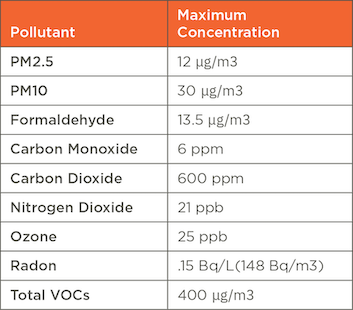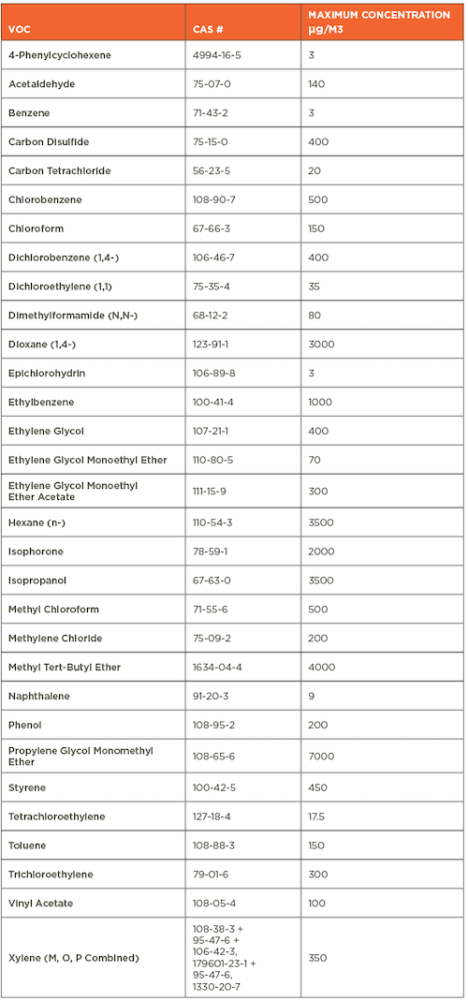INDOOR AIR QUALITY (IAQ) TESTING CLARIFICATIONS
The following protocols are intended to serve as a guide for indoor air quality (IAQ) testing professionals when performing the IAQ testing one to six months after occupancy, as well as for any required spot tests in this Imperative. For projects pursuing the continuous monitoring pathway, see the Continuous IAQ Monitoring Clarification for guidelines and requirements.
Testing Protocols
Testing should follow testing protocols consistent with the United States Environmental Protection Agency’s (EPA’s) Compendium of Methods for the Determination of Air Pollutants in Indoor Air, International Organization for Standardization (ISO) 16000 series, with the following exception:
- Formaldehyde and Acetaldehyde are sampled and measured according to ISO 16000-3 and ASTM D5197.
- Radon testing may also be conducted according to the current ANSI/AARST Protocol for Conducting Measurements of Radon and Radon Decay Products applicable to the building type.
Equivalent methods may also be used if approved in advance through a Request for Ruling as specified below.
Equivalent Methods
At the discretion of the project’s IAQ professional, project teams may use equivalent methods to the EPA’s Compendium of Methods for the Determination of Air Pollutants in Indoor Air or the ISO 16000 series. Project teams must submit a case for an equivalent method to Request for Ruling for preapproval.
Indoor Testing Requirements
Indoor tests should occur:
- One to six months after full building occupancy (a building is considered to be fully occupied when it is at 85% of full capacity and being used for its intended use).
- While the project is occupied and operated normally during business hours with at least 75% of regular occupants present i.e., 24 hours prior to and during all testing.
- For a minimum of four hours in each area, or as defined by the approved protocol.
- In the anticipated breathing zones of people using the space (approximately 1m or 3ft above the floor for seated people and 1.5m or 5ft above the floor for standing people).
Indoor Sample Points
Commercial and institutional buildings must provide:
- At least one data set per each contiguous floor.
- At least one data set per 25,000sf (approximately 2,325sm) per floor.
- Data sets at areas with the least ventilation and greatest presumed source of toxins.
- Sampling points for each distinct use area regardless of square footage.
Single-family residential projects must provide:
- One data set for each 2,000sf (190sm).
Multi-family residential projects must provide:
- One data set from a representative unit, and
- One data set for each other major use area (e.g., common room, hall, etc.).
Systems Conditions During Tests
Mechanical ventilation systems must:
- Operate in normal occupancy mode.
Central HVAC systems must:
- Not be in air economizer mode (where more than minimum outdoor air is introduced during cooling cycle when cool outdoor air is available).
- Operate with the minimum outdoor air required by the local jurisdiction.
- Operate with all of the building’s doors and windows closed for 24 hours prior to testing except during ingress and egress.
- The IAQ testing firm should be given unrestricted access to the HVAC system monitoring data that will be used to complete the IAQ post-occupancy testing.
Natural ventilation systems must:
- Function optimally with windows open the minimum amount needed to maintain minimum ventilation rates and comfort conditions.
- Be documented by the building facilities / operations manager, describing in detail the natural ventilation conditions during testing.
Electrical systems should:
- Remain on during testing.
Final Testing Report
The final IAQ testing report should include:
- Date, times, and locations tested, including location testing criteria.
- Executive summary
- Descriptions of sampling methods and conditions, including:
- Instruments used—name, model number, and use
- Calibration certifications of the test equipment used
- Airflow sampling rates
- Environmental lab accreditations, qualifications, and certifications verifying that testing was executed per the methods specified under the Testing Protocols section above.
- Qualifications of air sampling staff
- Approximate number of occupants and occupant activities
- HVAC system configuration
- Windows’ status (i.e., amount open) and weather
- Unusual conditions or events prior to or during the testing
- Written confirmation from building facilities / operations manager that the relevant “systems conditions” (above) were met
- Findings
- Environmental lab report
- Interpretation of the lab report and its findings
- Conclusion(s) and recommendation(s)
Maximum Allowable Concentrations
The following thresholds are intended to serve as a guide for IAQ professionals. Though these concentrations may not be exceeded, there may be circumstances in which smaller concentrations of certain substances pose a health risk, in which case the Institute recommends project teams meet the lower levels. If the IAQ testing reveals concentrations of any substances exceeding the limits listed below, the project team must put in place an action plan to reduce exposure to requirement levels and a re-test must be performed to show compliance.
Table 10-1 Maximum Pollutant Concentrations

Table 10-2 Maximum VOC Concentrations

Continuous IAQ Monitoring
Project teams may meet indoor air quality sampling requirements by showing compliance with an ILFI-approved continuously monitored indoor air quality standard in lieu of performing a comprehensive IAQ test one to six months after occupancy.
Projects pursuing the continuous IAQ monitoring pathway must additionally perform IAQ testing, at one to six months after full building occupancy, for any pollutants in Table 10-1 that are not monitored by the continuous monitoring devices accredited under the ILFI-approved standard. For example, some systems do not monitor PM10, Formaldehyde, Carbon Monoxide, Carbon Dioxide, Nitrogen Dioxide, Ozone, and Radon, so project teams would need to perform the one time IAQ test for these substances and show compliance with the thresholds in Table 10-1. If projects do not pass any of the spot tests, remediation measures must be implemented and a re-test for that pollutant subsequently performed to confirm that thresholds are met.
Continuous IAQ monitors must at a minimum monitor for:
- PM2.5
- Total VOCs
- CO
- CO monitors must be installed and comply with guidance provided in the Healthy Indoor Environment Plan Clarification under Imperative I09 Healthy Interior Environment
- CO2
- CO2 monitors must be installed and calibrated to 1000 ppm; or in Transects L3-L6, +500 ppm from outdoor levels.
- Temperature
- Humidity
- Both temperature and humidity must be monitored; no maximum levels are specified.
Approved Continuous IAQ Monitoring Standards
RESET Air is an ILFI-approved continuous IAQ monitoring standard. By the end of the LBC project’s twelve-month performance period, the project must be RESET certified and additionally have passing test results for any required IAQ spot tests for pollutants not measured by the continuous monitors, as described above.
Any alternate continuous IAQ monitoring standards must be approved in advance for through the Request for Ruling, noting that any proposed alternate standard should include specific requirements for equipment certification, system installation, and data collection.
Single Family and Small Multifamily Homes
Single-family home projects and multifamily buildings consisting of 4 units or fewer wishing to pursue the continuous IAQ monitoring pathway must meet all requirements identified above under the Continuous Monitoring clarification, with the following differences:
- Only monitors accredited by ILFI-approved continuous monitoring standards may be used. They do not need to be permanently installed, but must be installed and provide monitoring data for a minimum of 30 days without interruption.
- Monitoring and any spot tests must occur in each residential unit at the frequency of 1 dataset per 2,000sf (186sm) of area
- Monitors must be placed in the location that represents the potential worst case scenario for indoor air quality
- Certification under ILFI-approved standards is encouraged, but not required, however data from the continuous monitor and any required spot tests must show compliance with the maximum concentrations for all of the pollutants identified in Table 10-1.
- Notwithstanding the pollutants listed in Table 10-1, project teams may omit testing or monitoring of:
- Carbon monoxide and nitrogen dioxide if they can demonstrate that there is no attached enclosed garage, or combustion-based appliances or equipment within the building footprint as might be permitted in accordance with limitations specified in I07 Energy + Carbon Reduction.
- Ozone, if they can demonstrate that there is no potential source in the home, including ozone generators sold as air purifiers.
- Radon sampling results from pre-construction monitoring are acceptable, except that if results show concentrations in excess of the threshold cited in Table 10-1, measures must be installed to ensure radon does not enter the home. An additional short- or long-term test must be conducted 1 to 6 months after project completion with results showing compliance with the thresholds in Table 10-1. If thresholds are exceeded in the post-construction test, remediation measures must be implemented and a re-test subsequently performed that confirms that thresholds are met.



